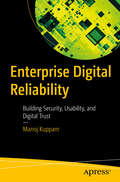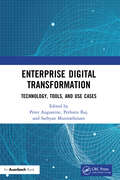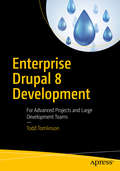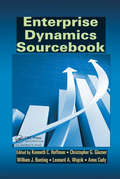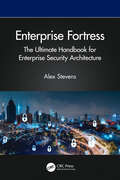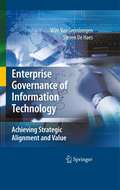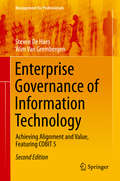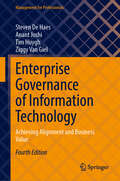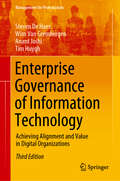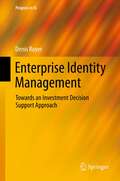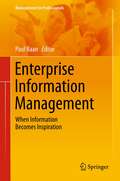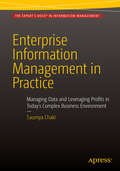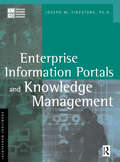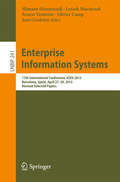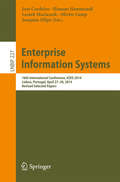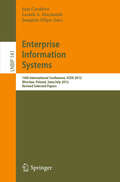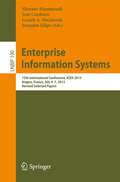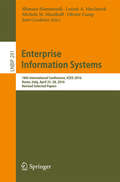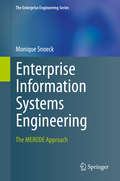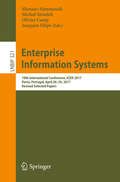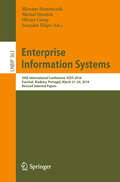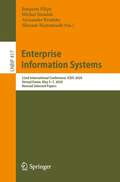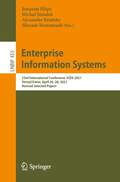- Table View
- List View
Enterprise Digital Reliability: Building Security, Usability, and Digital Trust
by Manoj KuppamGain a comprehensive understanding of digital reliability to ensure consistent, dependable user experiences that foster trust in technology. Part of author Saurav Bhattacharya’s trilogy that covers the essential pillars of digital ecosystems—security, reliability, and usability—this book tackles the challenges of achieving high reliability in complex systems and provides strategies to overcome these obstacles. You’ll start by reviewing the pivotal role of reliability in establishing the foundation of digital trust, essential for the sustainable growth of digital ecosystems. In today's digital landscape, characterized by rapid technological advancements and increasing cyber threats, understanding and addressing reliability issues are paramount. As transformative technologies like AI, blockchain, and quantum computing emerge, grasping these fundamental principles becomes crucial. Enterprise Digital Reliability advocates for collaborative efforts among technologists, policymakers, and society to create digital environments that are innovative, inclusive, safe, and respectful of human values. What You Will Learn Understand the multifaceted concept of reliability in technology and its significance in building digital trust Foster innovation and inclusivity in digital environments and large-scale enterprise and explore strategies to address them effectively Provide a framework for understanding and achieving digital equilibrium Examine operational uptime and consistent user experiences crucial to successful digital platforms Who This Book Is For Cybersecurity Professionals, Technology Developers and Engineers
Enterprise Digital Transformation: Technology, Tools, and Use Cases
by Pethuru Raj Sathyan Munirathinam Peter AugustineDigital transformation (DT) has become a buzzword. Every industry segment across the globe is consciously jumping toward digital innovation and disruption to get ahead of their competitors. In other words, every aspect of running a business is being digitally empowered to reap all the benefits of the digital paradigm. All kinds of digitally enabled businesses across the globe are intrinsically capable of achieving bigger and better things for their constituents. Their consumers, clients, and customers will realize immense benefits with real digital transformation initiatives and implementations. The much-awaited business transformation can be easily and elegantly accomplished with a workable and winnable digital transformation strategy, plan, and execution. There are several enablers and accelerators for realizing the much-discussed digital transformation. There are a lot of digitization and digitalization technologies available to streamline and speed up the process of the required transformation. Industrial Internet of Things (IIoT) technologies in close association with decisive advancements in the artificial intelligence (AI) space can bring forth the desired transitions. The other prominent and dominant technologies toward forming digital organizations include cloud IT, edge/fog computing, real-time data analytics platforms, blockchain technology, digital twin paradigm, virtual and augmented reality (VR/AR) techniques, enterprise mobility, and 5G communication. These technological innovations are intrinsically competent and versatile enough to fulfill the varying requirements for establishing and sustaining digital enterprises. Enterprise Digital Transformation: Technology, Tools, and Use Cases features chapters on the evolving aspects of digital transformation and intelligence. It covers the unique competencies of digitally transformed enterprises, IIoT use cases, and applications. It explains promising technological solutions widely associated with digital innovation and disruption. The book focuses on setting up and sustaining smart factories that are fulfilling the Industry 4.0 vision that is realized through the IIoT and allied technologies.
Enterprise Drupal 8 Development
by Todd TomlinsonSuccessfully architect a Drupal 8 website that scales to meet project requirements of any size and scope. Starting with a one-chapter review of Drupal basics, you'll dive into deeper topics including software development processes, architecting a Drupal site, scaling Drupal, working effectively with themes, and more. In addition to a thorough discussion of custom module development and how to develop modules as building blocks, you'll also review many common ways of integrating Drupal with other 3rd party systems.Building and maintaining an enterprise-ready Drupal website presents a unique set of challenges and complexities. From development processes and content management to deployments, version control and more, all aspects of Drupal development are impacted when two or more developers are on a project. If you are involved in a Drupal project that requires frequent updates and long-term support from a team of developers, system administrators, and end-users, Enterprise Drupal 8 Development is for you. Whether you're an experienced Drupal developer looking to expand your skills, a systems administrator managing a Drupal project, or a PHP developer new to Drupal, Enterprise Drupal 8 Development will give you the knowledge and inspiration you need to manage large and complex projects.What You'll LearnArchitect Drupal for development teams and apply best practices for large Drupal projectsIntegrate 3rd party applications with DrupalManage content, code, and configuration across multiple staging environmentsBuild a consistent user experience for administrators and content creatorsWho This Book Is ForThe primary audience is intermediate to advanced Drupal developers who are working on large-scale Drupal projects and advanced PHP developers new to DrupalThe secondary audience is IT Professionals such as Systems Administrators managing Drupal projects
Enterprise Dynamics Sourcebook
by Kenneth C. Hoffman Christopher G. Glazner William J. Bunting Leonard A. Wojcik Anne CadyRapidly changing market, technological, and organizational environments are forcing government and private sector enterprises to improve services and transform processes. Employing a case study approach, the Enterprise Dynamics Sourcebook presents frameworks and analytical models of the enterprise as a complex system to improve your understanding o
Enterprise Fortress: The Ultimate Handbook for Enterprise Security Architecture
by Alex StevensEnterprise Fortress is a comprehensive guide to building secure and resilient enterprise architectures, aimed at professionals navigating the complex world of cybersecurity. Authored by cybersecurity leader Alex Stevens, the book brings together his experience of over 20 years, blending technical expertise with business strategy. It covers everything from foundational principles to advanced topics, focusing on aligning security with organisational goals. What sets this book apart is its practical, real-world focus – grounded in hands-on experience and strategic insights, it provides actionable advice that can be immediately applied.This book equips readers with the knowledge to tackle the evolving landscape of cybersecurity. Whether you’re developing security frameworks, handling governance and compliance, or leading a security team, Enterprise Fortress has you covered. By combining best practices with innovation, it provides tools and strategies for both current challenges and future threats.Key Features: Clear, step-by-step instructions on designing and implementing enterprise security architectures. Practical frameworks for integrating security into the business strategy. Detailed insights into governance, risk management, and compliance with regulations like GDPR and ISO 27001. Case studies that highlight real-world challenges and solutions from various industries. Exploration of advanced topics like security automation, orchestration, and emerging cyber threats. Guidance on building and leading effective cybersecurity teams and fostering a security-aware culture within organisations. Enterprise Fortress is perfect for cybersecurity professionals, IT leaders, enterprise architects, and business executives responsible for securing their organisations. Whether you’re an experienced architect or new to the field, this book offers the technical know-how and leadership insights to help you strengthen your organisation’s security posture and stay ahead of emerging threats.
Enterprise Governance of Information Technology
by Wim Van Grembergen Steven De HaesEnterprise governance of information technology is a relatively new concept that is gaining traction in both the academic and practitioner worlds. Going well beyond the implementation of a superior IT infrastructure, "Enterprise Governance of Information Technology" is about defining and embedding processes and structures throughout the organizations that enable both business and IT people to execute their responsibilities, while maximizing the value created from their IT-enabled investments. At the forefront of the field, the authors draw from years of research and advising corporate clients to present the first comprehensive resource on the topic. Featuring numerous case examples from companies around the world, the book integrates theoretical advances and empirical data with practical application, including in-depth discussion of such frameworks as COBIT and VALIT, which are used to measure and audit the value of IT investments and ensuring regulatory compliance. A variety of elements, including executive summaries and sidebars, extensive references, and questions and activities (with additional materials available on-line) ensure that the book will be an essential resource for professionals, researchers, and students alike.
Enterprise Governance of Information Technology
by Steven Haes Wim GrembergenFeaturing numerous case examples from companies around the world, this second edition integrates theoretical advances and empirical data with practical applications, including in-depth discussion on the COBIT 5 framework which can be used to build, measure and audit enterprise governance of IT approaches. At the forefront of the field, the authors of this volume draw from years of research and advising corporate clients to present a comprehensive resource on enterprise governance of IT (EGIT). Information technology (IT) has become a crucial enabler in the support, sustainability and growth of enterprises. Given this pervasive role of IT, a specific focus on EGIT has arisen over the last two decades, as an integral part of corporate governance. Going well beyond the implementation of a superior IT infrastructure, enterprise governance of IT is about defining and embedding processes and structures throughout the organization that enable boards and business and IT people to execute their responsibilities in support of business/IT alignment and value creation from their IT-enabled investments. Featuring a variety of elements, including executive summaries and sidebars, extensive references and questions and activities (with additional materials available on-line), this book will be an essential resource for professionals, researchers and students alike
Enterprise Governance of Information Technology: Achieving Alignment and Business Value (Management for Professionals)
by Anant Joshi Tim Huygh Steven De Haes Ziggy Van GielThis book integrates theoretical advances and empirical data on enterprise governance of information technology (EGIT) with practical applications based on numerous case examples. In its fourth revised edition, this book provides practitioners and students with the most recent research advancements as well as a significantly reworked chapter on IT business value. The authors also include an in-depth discussion on control objectives for information and related technologies (COBIT) 2019 framework and an overview of complimentary methodologies such as Information Technology Infrastructure Library (ITIL) and ISO standards and SAFe. Furthermore, the existing chapters are supplemented by relevant theoretical perspectives that are foundational to understanding the enclosed concepts thoroughly. Featuring a variety of elements, including executive summaries and sidebars, extensive references, questions and activities and additional online materials, this book is a valuable updated resource for professionals, students and researchers alike.
Enterprise Governance of Information Technology: Achieving Alignment and Value in Digital Organizations (Management for Professionals)
by Anant Joshi Tim Huygh Steven De Haes Wim Van GrembergenThis book integrates theoretical advances and empirical data on Enterprise Governance in Information Technology (EGIT) with practical applications based on numerous case examples. The third revised edition of Enterprise Governance of Information Technology provides professionals and students with the most recent research advancements as well as an in-depth discussion of the recently-introduced Control Objectives for Information and Related Technologies (COBIT) 2019 framework which can be used to facilitate a tailored implementation of effective EGIT. Furthermore, the book features a new chapter which provides readers with hands-on examples from practice and clear insights on how these relate to theory. At the forefront of the field, the authors of this volume draw from years of research and advising corporate clients to present a comprehensive resource on EGIT. Featuring a variety of elements, including executive summaries and sidebars, extensive references, questions and activities and additional online materials, this book is a valuable updated resource for professionals, students and researchers alike.
Enterprise Identity Management
by Denis RoyerThe introduction of Enterprise Identity Management Systems (EIdMS) in organizations even beyond the purely technological level is a costly and challenging endeavor. However, for decision makers it seems difficult to fully understand the impacts and opportunities arising from the introduction of EIdMS. This book explores the relevant aspects for an ex-ante evaluation of EIdMS. Therefore it examines this domain by employing a qualitative expert interview study to better understand the nature of EIdMS, as they are situated between security and productive IT systems. To this regard, the focus is put on the general nature of EIdMS projects and the constructs being relevant for analyzing such projects in the decision support phase. Based on the derived constructs and thematic topics from the interviews, an explanatory model for EIdMS introductions is derived and iteratively improved and evaluated. Finally, a possible application use-case for the creation of adequate decision support tools is presented.
Enterprise Information Management
by Paul BaanHow an organization manages its information is arguably the most important skill in today's dynamic and hyper-competitive environment. In Enterprise Information Management, editor Paul Baan and a team of expert contributors present a holistic approach to EIM, with an emphasis on action-oriented decision making. The authors demonstrate that EIM must be promoted from the top down, in order to ensure that the entire organization is committed to establishing and supporting the systems and processes designed to capture, store, analyze, and disseminate information. They identify three key "pillars" of applications: (1) business intelligence (the information and knowledge management process itself); (2) enterprise content management (company-wide management of unstructured information, including document management, digital asset management, records management, and web content management); and (3) enterprise search (using electronic tools to retrieve information from databases, file systems, and legacy systems). The authors explore EIM from economic and socio-psychological perspectives, considering the "ROI" (return on information) of IT and related technological investments, and the cultural and behavioral aspects through which people and machines interact. Illustrating concepts through case examples, the authors provide a variety of tools for managers to assess and improve the effectiveness of their EIM infrastructure, considering its implications for customer and client relations, process and system improvements, product and service innovations, and financial performance.
Enterprise Information Management in Practice
by Saumya ChakiLearn how to form and execute an enterprise information strategy: topics include data governance strategy, data architecture strategy, information security strategy, big data strategy, and strategy to move data warehouses to the cloud. Manage information like a pro, to achieve much better financial results for the enterprise, more efficient processes, and multiple advantages over competitors. As you''ll discover in Enterprise Information Management in Practice, EIM deals with both structured data (e. g. sales data and customer data) as well as unstructured data (like customer satisfaction forms, emails, documents, social network sentiments, and so forth). With the deluge of information that enterprises face given their global operations and complex business models, as well as the advent of big data technology, it is not surprising that making sense of the large piles of data is of paramount importance. Enterprises must therefore put much greater emphasis on managing and monetizing both structured and unstructured data. As Saumya Chaki--an information management expert and consultant with IBM--explains in Enterprise Information Management in Practice, it is now more important than ever before to have an enterprise information strategy that covers the entire life cycle of information and its consumption while providing security controls. With Fortune 100 consultant Saumya Chaki as your guide, Enterprise Information Management in Practice covers each of these and the other pillars of EIM in depth, which provide readers with a comprehensive view of the building blocks for EIM. Enterprises today deal with complex business environments where information demands take place in real time, are complex, and often serve as the differentiator among competitors. The effective management of information is thus crucial in managing enterprises. Enterprise Information Management (EIM) has evolved as a specialized discipline in the business intelligence and enterprise data warehousing space to address the complex needs of information processing and delivery--and to ensure the enterprise is making the most of its information assets. What you''ll learn The structure of your enterprise information management (EIM) program What kinds of data management strategies you need in place as part of the EIM program The key benefits of an EIM program The solution components in an EIM program The incremental roadmap to building an EIM organization and leverage the benefits Who this book is for All practitioners of information management including business information analysts, data scientists, IT professionals, IT managers, database administrators, senior information executives, and many others. While there are numerous books on data management and big data, there are very few books that tie up all the concepts in a holistic manner. Table of Contents Chapter 1: Enterprise Information Management : Definition, Scope, and History Chapter 2: Lifecycle of Enterprise Information Management Chapter 3: Components of Enterprise Information Management Chapter 4: Pillar #1: Information Sourcing Chapter 5: Pillar #2: Information Integration and Exchange Chapter 6: Pillar #3: Information Governance and Quality Chapter 7: Pillar #4: Master Information Management Chapter 8: Pillar #5: Information Warehousing Chapter 9: Pillar #6: Information Delivery and Consumption Chapter 10: Pillar #8: Metadata Management Chapter 11: Pillar #9: Big Data Components Chapter 12: Building an Enterprise Information Management Solution Chapter 13: EIM in Today''s Business Environment Appendix A - Glossary Appendix B - EIM Tools in the Marketplace
Enterprise Information Portals and Knowledge Management (Kmci Press Ser.)
by Joseph M. FirestoneIs the Enterprise Information Portal (EIP) knowledge management's killer app? Leading expert Joseph M. Firestone, the first author to formulate the idea of the Enterprise Knowledge Portal, breaks new ground and looks to the future with a practical, but comprehensive approach to enterprise portals and their relationship to knowledge management. Providing a clear and novel overview, Firestone tackles a wide range of topics ranging from functional EIP applications, estimating costs and benefits of EIPs, variations in EIP technical architecture, the role of intelligent agents, the nature of knowledge management, portal product/solution segmentation, portal product case studies, to the future of the EIP space. 'Enterprise Information Portals and Knowledge Management' is the book on portals you've been waiting for. It is the only book that thoroughly considers, explores, and analyzes:* The EIP orientation, outlook and evolution* A new methodology for estimating EIP benefits and costs* EIP and Enterprise Knowledge Portals (EKP) architecture* The approaching role of software agents in EIPs and EKPs* The current and future contribution of EIP and EKP solutions to Knowledge Management* The role of XML in portal architecture * A comprehensive, multi-dimensional, and forward-looking segmentation of EIP products accompanied by portal product case studies* Where EIP sector companies are headed and the pathways they will follow to get there
Enterprise Information Systems
by Slimane Hammoudi Olivier Camp José Cordeiro Leszek Maciaszek Ernest TenienteThis book contains revisedpapers from the 17th International Conference on Enterprise Information Systems, ICEIS 2015, held in Barcelona, Spain, in April 2015. The 31 papers presented in this volume were carefully reviewed andselected from a total of 327 submissions. The book also contains one full-paper invited talk. Theselected papers reflect state-of-the-art research that is oriented towardreal-world applications and highlight the benefits of information systems andtechnology for industry and services. They are organized in topical sections ondatabases and information systems integration, artificial intelligence anddecision support systems, information systems analysis and specification,software agents and Internet computing, human-computer interaction, andenterprise architecture.
Enterprise Information Systems
by Joaquim Filipe Slimane Hammoudi Olivier Camp José Cordeiro Leszek MaciaszekThis book contains extended and revised papers from the 16th International Conference on Enterprise Information Systems, ICEIS 2014, held in Lisbon, Portugal, in April 2014. The 24 papers presented in this volume were carefully reviewed and selected from a total of 313 submissions. The book also contains two full-paper invited talks. The selected papers reflect state-of-the-art research that is oriented toward real-world applications and highlight the benefits of information systems and technology for industry and services. They are organized in topical sections on databases and information systems integration, artificial intelligence and decision support systems, information systems analysis and specification, software agents and Internet computing, human-computer interaction, and enterprise architecture.
Enterprise Information Systems
by Leszek A. Maciaszek Joaquim Filipe José CordeiroThis book contains substantially extended and revised versions of the best papers from the 14th International Conference on Enterprise Information Systems (ICEIS 2012), held in Wroclaw, Poland, in June/July 2012. The 25 full and 3 invited papers included in this volume were carefully reviewed and selected from 299 submissions. They reflect state-of-the-art research work focusing mainly on real-world applications and highlighting the benefits of information systems and technology for industry and services, thus connecting academia with the world of real enterprises. The topics covered are: databases and information systems integration; artificial intelligence and decision support systems; information systems analysis and specification; software agents and internet computing; human-computer interaction; and enterprise architecture.
Enterprise Information Systems
by Leszek A. Maciaszek Joaquim Filipe Slimane Hammoudi José CordeiroThis book contains substantially extended and revised versions of the best papers from the 15th International Conference on Enterprise Information Systems, ICEIS 2013, held in Angers, France, in July 2013. The 29 full and two invited papers included in this volume were carefully reviewed and selected from 321 submissions. They reflect state-of-the-art research focusing mainly on real-world applications and highlight the benefits of information systems and technology for industry and services, thus connecting academia with the world of real enterprises. The topics covered are: databases and information systems integration, artificial intelligence and decision support systems, information systems analysis and specification, software agents and Internet computing, human-computer interaction, and enterprise architecture.
Enterprise Information Systems
by Leszek A. Maciaszek Slimane Hammoudi Olivier Camp José Cordeiro Michele M. MissikoffThis book comprises a set of papers selected from those presented at the fifth #65533; International Conference on Enterprise Information Systems #65533;, (ICEIS'2003) held in Angers, France, from 23 to 26 April 2003. The conference was organised by #65533;cole Sup#65533;rieure d'#65533;lectronique de l'Ouest (ESEO) of Angers, France and the Escola Superior de Tecnologia of Set#65533;bal, Portugal. Since its first edition in 1999, ICEIS focuses on real world applications and aims at bringing together researchers, engineers and practitioners interested in the advances and business applications of information systems. As in previous years, ICEIS'2003 held four simultaneous tracks covering different aspects of enterprise computing: Databases and Information Systems Integration, Artificial Intelligence and Decision Support Systems, Information Systems Analysis and Specification and Software Agents and Internet Computing. Although ICEIS'2003 received 546 paper submissions from over 50 countries, only 80 were accepted as full papers and presented in 30-minutes oral presentations. With an acceptance rate of 15%, these numbers demonstrate the intention of preserving a high quality forum for future editions of this conference. From the articles accepted as long papers for the conference, only 32 were selected for inclusion in this book Additional keynote lectures, tutorials and industrial sessions were also held during ICEIS'2003, and, for the first time this year, the 1st Doctoral Consortium on Enterprise Information Systems gave PhD students an opportunity to present their work to an international audience of experts in the field of information systems.
Enterprise Information Systems Engineering
by Monique SnoeckThe increasing penetration of IT in organizations calls for an integrative perspective on enterprises and their supporting information systems. MERODE offers an intuitive and practical approach to enterprise modelling and using these models as core for building enterprise information systems. From a business analyst perspective, benefits of the approach are its simplicity and the possibility to evaluate the consequences of modeling choices through fast prototyping, without requiring any technical experience. The focus on domain modelling ensures the development of a common language for talking about essential business concepts and of a shared understanding of business rules. On the construction side, experienced benefits of the approach are a clear separation between specification and implementation, more generic and future-proof systems, and an improved insight in the cost of changes. A first distinguishing feature is the method's grounding in process algebra provides clear criteria and practical support for model quality. Second, the use of the concept of business events provides a deep integration between structural and behavioral aspects. The clear and intuitive semantics easily extend to application integration (COTS software and Web Services). Students and practitioners are the book's main target audience, as both groups will benefit from its practical advice on how to create complete models which combine structural and behavioral views of a system-to-be and which can readily be transformed into code, and on how to evaluate the quality of those models. In addition, researchers in the area of conceptual or enterprise modelling will find a concise overview of the main findings related to the MERODE project. The work is complemented by a wealth of extra material on the author's web page at KU Leuven, including a free CASE tool with code generator, a collection of cases with solutions, and a set of domain modelling patterns that have been developed on the basis of the method's use in industry and government.
Enterprise Information Systems: 14th International Conference, ICEIS 2012, Wroclaw, Poland, June 28 - July 1, 2012, Revised Selected Papers (Lecture Notes in Business Information Processing #141)
by Leszek A. Maciaszek Joaquim Filipe José CordeiroThis book contains substantially extended and revised versions of the best papers from the 14th International Conference on Enterprise Information Systems (ICEIS 2012), held in Wroclaw, Poland, in June/July 2012.The 25 full and 3 invited papers included in this volume were carefully reviewed and selected from 299 submissions. They reflect state-of-the-art research work focusing mainly on real-world applications and highlighting the benefits of information systems and technology for industry and services, thus connecting academia with the world of real enterprises.The topics covered are: databases and information systems integration; artificial intelligence and decision support systems; information systems analysis and specification; software agents and internet computing; human-computer interaction; and enterprise architecture.Chapter “Time Efficiency of Point-of-Sale Payment Methods: Empirical Results for Cash, Cards and Mobile Payments” is available open access under a Creative Commons Attribution 4.0 International License via link.springer.com.
Enterprise Information Systems: 19th International Conference, ICEIS 2017, Porto, Portugal, April 26-29, 2017, Revised Selected Papers (Lecture Notes in Business Information Processing #321)
by Joaquim Filipe Slimane Hammoudi Olivier Camp Michał ŚmiałekThis book constitutes extended and revised papers from the 19th International Conference on Enterprise Information Systems, ICEIS 2017, held in Porto, Portugal, in April 2017. The 28 papers presented in this volume were carefully reviewed and selected for inclusion in this book from a total of 318 submissions. They were organized in topical sections named: databases and information systems integration; artificial intelligence and decision support systems; information systems analysis and specification; software agents and internet computing; human-computer interaction; and enterprise architecture.
Enterprise Information Systems: 20th International Conference, ICEIS 2018, Funchal, Madeira, Portugal, March 21-24, 2018, Revised Selected Papers (Lecture Notes in Business Information Processing #363)
by Joaquim Filipe Slimane Hammoudi Olivier Camp Michał ŚmiałekThis book constitutes extended, revised and selected papers from the 20th International Conference on Enterprise Information Systems, ICEIS 2018, held in Funchal, Madeira, Portugal, in March 2018. The 19 papers presented in this volume were carefully reviewed and selected for inclusion in this book from a total of 242 submissions. They deal with topics such as data science and databases; ontologies; social networks; knowledge management; software development; human-computer interaction, and multimedia.
Enterprise Information Systems: 21st International Conference, ICEIS 2019, Heraklion, Crete, Greece, May 3–5, 2019, Revised Selected Papers (Lecture Notes in Business Information Processing #378)
by Joaquim Filipe Slimane Hammoudi Michał Śmiałek Alexander BrodskyThis book constitutes extended, revised and selected papers from the 21st International Conference on Enterprise Information Systems, ICEIS 2019, held in Heraklion, Crete, Greece, in May 2019. The 26 papers presented in this volume were carefully reviewed and selected for inclusion in this book from a total of 205 submissions. They deal with topics such as data science and databases; ontologies; social networks; knowledge management; software development; human-computer interaction, and multimedia.
Enterprise Information Systems: 22nd International Conference, ICEIS 2020, Virtual Event, May 5–7, 2020, Revised Selected Papers (Lecture Notes in Business Information Processing #417)
by Joaquim Filipe Slimane Hammoudi Michał Śmiałek Alexander BrodskyThis book constitutes extended, revised and selected papers from the 22nd International Conference on Enterprise Information Systems, ICEIS 2020, held online during May 5-7, 2020.The 41 papers presented in this volume were carefully reviewed and selected for inclusion in this book from a total of 255 submissions. They were organized in topical sections as follows: database and information systems integration; artificial intelligence and decision support systems; information systems analysis and specification; software agents and internet computing; human-computer interaction; and enterprise architecture.
Enterprise Information Systems: 23rd International Conference, ICEIS 2021, Virtual Event, April 26–28, 2021, Revised Selected Papers (Lecture Notes in Business Information Processing #455)
by Joaquim Filipe Slimane Hammoudi Michał Śmiałek Alexander BrodskyThis book contains extended, revised and selected papers from the 23rd International Conference on Enterprise Information Systems, ICEIS 2021, held online during April 2021. The 26 papers presented in this volume were carefully reviewed and selected for inclusion from a total of 241 submissions. They are grouped in sections on databases and information systems integration, artificial intelligence and decision support systems, information systems analysis and specification, software agents and internet computing, human-computer interaction, and enterprise architecture.
